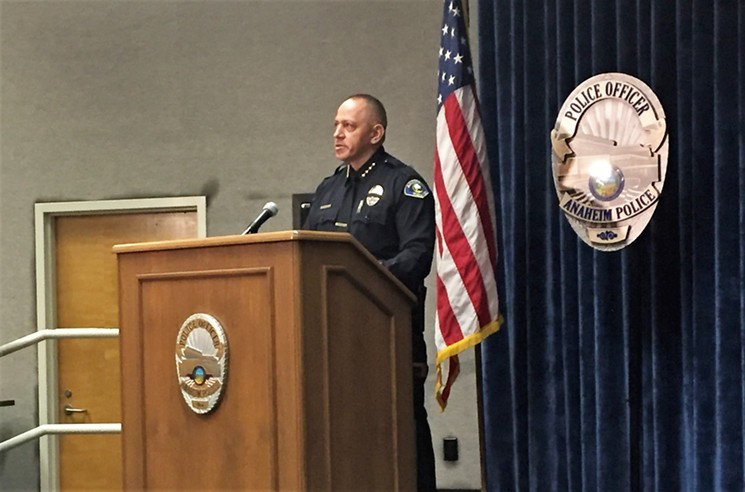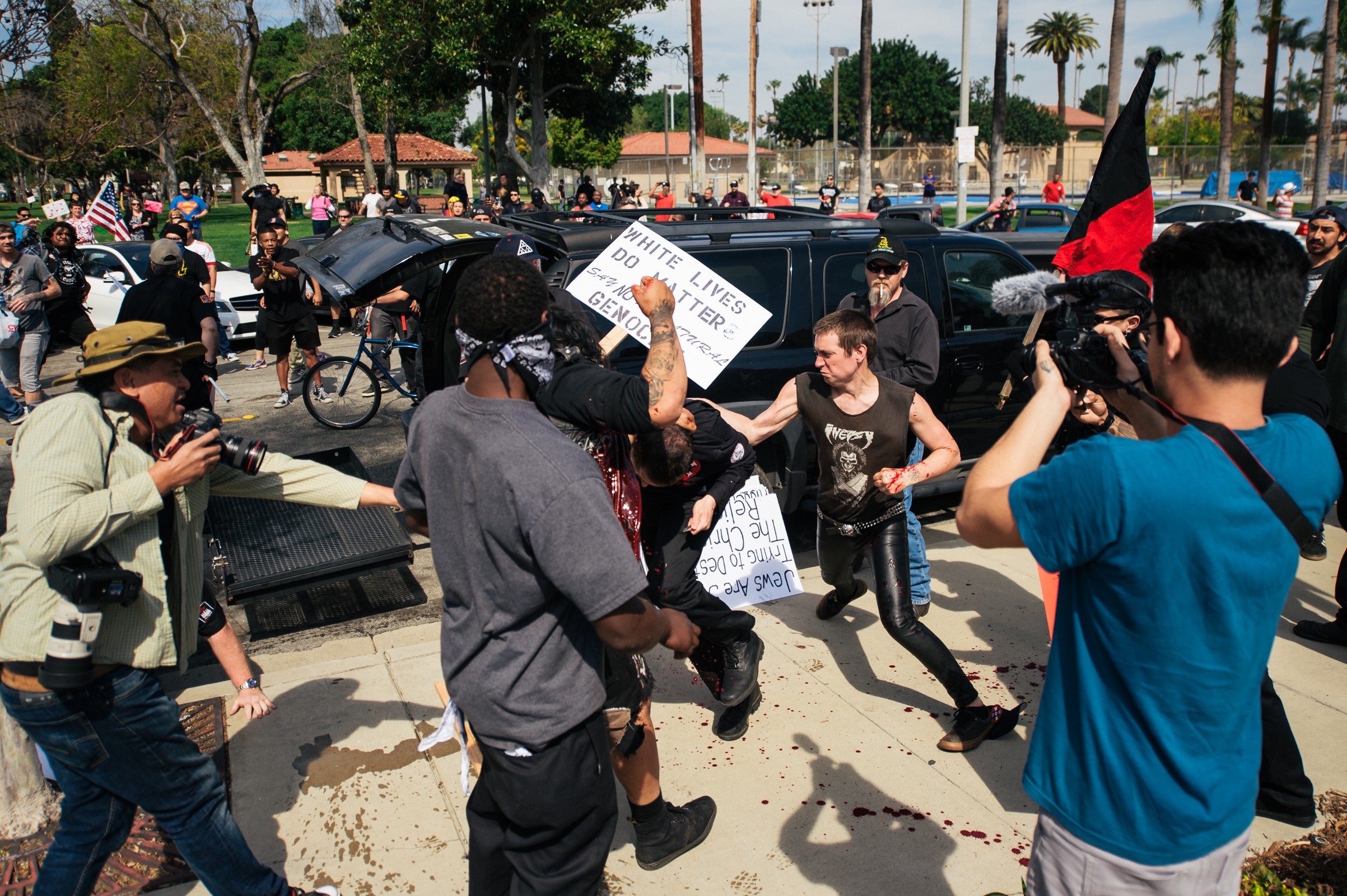 UPDATE, AUG. 10, 6:23 P.M.: Embattled Anaheim police chief Raul Quezada released a statement this afternoon in response to receiving a vote of no confidence from an overwhelming majority of his officers. “As Anaheim’s new and first Latino Chief of Police, my number one priority was—and remains—community engagement,” Quezada stated. “Cultural change is difficult and often requires tough decisions and new ideas that can be scary to police employees accustomed to doing their jobs a certain way.”
UPDATE, AUG. 10, 6:23 P.M.: Embattled Anaheim police chief Raul Quezada released a statement this afternoon in response to receiving a vote of no confidence from an overwhelming majority of his officers. “As Anaheim’s new and first Latino Chief of Police, my number one priority was—and remains—community engagement,” Quezada stated. “Cultural change is difficult and often requires tough decisions and new ideas that can be scary to police employees accustomed to doing their jobs a certain way.”
It’s true that Quezada’s meetings with mothers whose sons were killed by Anaheim police officers to discuss potential reforms out of the 2012 riots irked some in the department. When Sgt. Tony Montanarella criticized then-interim chief Quezada in the Register four years ago, he claimed the department had become “obsessed with catering to a very angry vocal minority with political agendas at the expense of the overwhelming majority of the population we serve who support us.” But the press release issued by the Anaheim Police Association (APA) this morning made no such mention in explaining its vote.
(An additional memo published by the APA did take issue with Donna Acevedo, whose son was killed by an Anaheim policeman in 2012, being allowed to go on a ride-a-long. The memo also links to the Weekly‘s Klan rally investigative reporting in offering further details on why officers felt the vote was necessary).
Quezada defended his tenure against the “No Confidence” vote, positioning himself as a champion of post-riot reforms aimed at building trust, especially with Anaheim’s working-class neighborhoods. He touts the department’s early embrace of body-worn cameras, which he says has led to less use of force incidents while providing key evidence against false claims made against his officers in the field. But when the footage reveals evidence of wrongdoing, the chief surmises that more Internal Affairs investigations don’t necessarily serve to endear him to the APA.
“Despite the union vote, I continue to have confidence in the men and women of APD,” Quezada stated. “I can’t help but question whether no confidence votes against reform-minded police chiefs who have yet to hit retirement age are part of a new playbook some local police unions are using to attempt to strong arm cities and police agencies.” The chief didn’t bother addressing criticisms made by the APA, including his handling of the KKK rally-turned-melee last year.
Carlos Rojas, Santa Ana’s first Latino police chief, received a vote of no confidence from the Santa Ana Police Officers’ Association leading to his resignation earlier this year. He went on to become the Bay Area Rapid Transit System’s new police chief and is now suing his former employer. The Huntington Beach Police Officers’ Association appears to be readying a vote of no confidence of its own against chief Robert Handy.
ORIGINAL POST, AUG. 10, 11:37 A.M.: Anaheim police chief Raul Quezada dodged accusations of time card fraud and mishandling a violent Ku Klux Klan rally at Pearson Park in 2016, but not a vote of no confidence by a majority of his officers. The Anaheim Police Association (APA) announced today that 87 percent of its surveyed members no longer support the chief. Rank-and-file officers further added that Quezada should step down, retire, or be removed.
“We did not undertake a vote of no confidence lightly as we have diligently attempted this year and many previous to get items back on track,” APA President Edgar Hampton said in a press release announcing the outcome. “We respect the office, authority and chain of command. However, working for Chief Quezada has become near impossible and we are on a downward spiral.”
The “No Confidence” vote doesn’t come as a complete surprise. The department’s fissures have surfaced publicly before; Sgt. Tony Montanarella blasted then-interim chief Quezada for “cronyism” in a 2013 Register op-ed. More recently, Captain Jarrett Young accused Quezada and Deputy Chief Dan Cahill last Fall of thieving public funds by falsifying time cards. The city contracted an outside firm to conduct an investigation into the latter accusation that cleared both of any wrongdoing.
In explaining its vote, the APA pointed out other examples of Quezada’s failed leadership including playing favorites in doling out important assignments, retaliating against officers who disagreed with his management style and being unable to unite his top brass. But the most glaring gripe the police association mentioned focused on Quezada’s failures to hold his managers to account for bungling police responses to major incidents like when “the horrible KKK held a rally” in the city last year.  Investigations by the Weekly into the KKK rally showed that internal police emails and copious police reports contradicted what Quezada told city council about how his force properly planned for the Feb. 27, 2016 “White Lives Do Matter” event that quickly turned into a bloody melee where a Klansman stabbed three counter-protesters. No uniformed officers patrolled the park until after the chaos erupted. The chief claimed to council that the Klan never specified when and where they planned to park for the start of the rally. He reiterated those same talking points during a later meeting of Anaheim’s Public Safety Board.
Investigations by the Weekly into the KKK rally showed that internal police emails and copious police reports contradicted what Quezada told city council about how his force properly planned for the Feb. 27, 2016 “White Lives Do Matter” event that quickly turned into a bloody melee where a Klansman stabbed three counter-protesters. No uniformed officers patrolled the park until after the chaos erupted. The chief claimed to council that the Klan never specified when and where they planned to park for the start of the rally. He reiterated those same talking points during a later meeting of Anaheim’s Public Safety Board.
But police emails showed that the Klan, indeed, told police before the rally that they planned on arriving around noon at the west side of the park—and proceeded to do just that. Hundreds of pages of police reports filed shortly after the KKK melee and before Quezada’s statements to council offered a consistent timeline that didn’t jive with chief’s odd claim that the KKK arrived unexpectedly at 11:30 a.m. that Saturday. Anaheim watchdog Duane Roberts filed a complaint against Quezada for misleading the public but a human resources probe found the chief simply didn’t have all the information about the KKK rally when he made his comments.
Judging by its overwhelming vote and characterization of the KKK rally, Anaheim’s rank-and-file officers didn’t buy it. Only 13 percent of APA members dissented from the “No Confidence” vote. “Sadly, the Anaheim Police Department continues to endure the most dysfunctional management team in the history of the department,” the APA’s press statement reads. “When asked for his plan to bring the department together at last week’s Training Auditorium Meeting, Chief Quezada took no responsibility and continued to blame others.”
Quezada quickly rose through the ranks following the Anaheim Riots five years ago. He took the reins of the department following Chief John Welter’s retirement in 2013. Quezada became Anaheim’s first-ever Latino police chief later that year capping a career with the department that first started in 1996. But now, he’s lost the confidence of his fellow officers.
The APA states that its vote may not be the last word on Quezada’s tenure. “We believe where there is smoke, there could be fire and believe there are more items associated with his management we have yet to learn about,” its press release reads. Time will tell.

Gabriel San Román is from Anacrime. He’s a journalist, subversive historian and the tallest Mexican in OC. He also once stood falsely accused of writing articles on Turkish politics in exchange for free food from DönerG’s!

